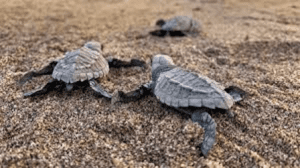TAG: GS 3: ECOLOGY AND ENVIRONMENT
THE CONTEXT: Chavakkad Beach in Thrissur, Kerala, has long been a vital nesting ground for Olive Ridley turtles. However, recent observations reveal a significant decline in turtle footfall at the beach, raising concerns among conservationists and local communities.
EXPLANATION:
- Olive Ridley turtles, classified as vulnerable in the IUCN Red List and protected under the Indian Wildlife Protection Act, play a crucial role in marine ecosystems.
- Their nesting habits contribute to biodiversity and ecosystem health, making their conservation imperative.
- Conservationists attribute the decline in turtle arrivals at Chavakkad Beach to the rising temperature.
- The increased temperature disrupts the turtles’ nesting patterns, affecting their migratory behavior and reducing their propensity to lay eggs on the shore.
- Historically, around 500 Olive Ridley turtles would arrive annually at Chavakkad Beach to lay eggs.
- However, recent reports indicate that only one-third of this usual number made an appearance, signaling a noticeable decline in turtle footfall.
- The delayed onset of the winter season exacerbates the situation, as turtles typically begin their nesting season in November when temperatures along the coast drop.
- The delayed winter may have disrupted the turtles’ migratory cues, leading to reduced nesting activity.
Community Conservation Efforts:
- Local communities, including fishermen, youngsters, and schoolchildren, have long been involved in turtle conservation efforts around Chavakkad Beach.
- Their initiatives have contributed to an increase in hatchling numbers entering the sea, highlighting the importance of community engagement in conservation.
Nesting Season and Success Rates:
- The nesting season for Olive Ridley turtles spans from November to February, during which a single turtle can lay approximately 120 eggs.
- These eggs typically take 45-60 days to hatch, with an impressive 80% hatch success rate observed at Chavakkad Beach in the past.
Significance of the Decline:
- The decline in turtle footfall at Chavakkad Beach represents the first such occurrence in a decade, underscoring the urgency of addressing environmental factors contributing to the turtles’ altered behavior.
- Understanding the drivers behind this decline is crucial for formulating effective conservation strategies.
Olive Ridley turtles:
- The Olive ridley turtles are the smallest and most abundant of all sea turtles found in the world.
- They are found to be inhabiting the warm waters of the Pacific, Atlantic, and Indian oceans.
- They are carnivores and feed mainly on jellyfish, shrimp, snails, crabs, molluscs, and a variety of fish and their eggs.
- The males and females grow to the same size.
- These turtles, along with their cousin the Kemps ridley turtle, are best known for their unique mass nesting called Arribada, where thousands of females come together on the same beach to lay eggs.
- The coast of Orissa in India is the largest mass nesting site for the Olive-ridley, followed by the coasts of Mexico and Costa Rica.
- The species is recognized as Vulnerable by the IUCN Red list.
- They lie in Scheduled 1 of the Wildlife Protection Act, 1972
- They are in Appendix I of the CITES.



